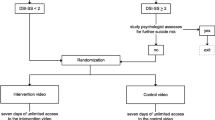Abstract
Purpose
The aim of this paper is to provide an analysis of data from the National Survey of Mental Health and Wellbeing (NSMHWB) on the factors associated with the use of sources of information on mental health. A further aim is to examine the associations between the use of information sources and professional help-seeking.
Methods
Data from the 2007 NSMHWB were used. The survey sample comprised 8,841 residents of private dwellings across Australia aged 16–85 years.
Results
Television was the most common source of information about mental health issues in the previous 12 months (accessed by 20.5% of respondents) followed by pamphlets and brochures (accessed by 15.6% of respondents). Having an anxiety or affective disorder, female gender, higher levels of education and having a family member with a mental health problem was associated with the seeking of information on mental health issues from the internet, non-fiction books and brochures/pamphlets. Accessing information on the internet was associated with increased use of any mental health services, GPs and mental health professionals (MHPs).
Conclusions
The results suggest that promotion of internet resources may offer the opportunity to increase help seeking for mental health problems and may offer the opportunity to engage those least likely to seek professional help, notably young males.
Similar content being viewed by others
References
Slade T, Johnston A, Oakley Browne MA, Andrews G, Whiteford H (2009) 2007 National Survey of Mental Health and Wellbeing: methods and key findings. Aust N Z J Psychiatry 43:594–605
Burgess PM, Pirkis JE, Slade TN, Johnston AK, Meadows GN, Gunn JM (2009) Service use for mental health problems: findings from the 2007 National Survey of Mental Health and Wellbeing. Aust N Z J Psychiatry 43:615–623
Reavley N, Cvetkovski S, Jorm A, Lubman DI (2010) Help seeking for substance use, anxiety and affective disorders among young people: results from the 2007 Australian National Survey of Mental Health and Wellbeing. Aust N Z J Psychiatry 44:729–735
Australian Bureau of Statistics (2008) Household Use of Information Technology, Australia, 2007–2008
Baker L, Wagner TH, Singer S, Bundorf MK (2003) Use of the Internet and e-mail for health care information: results from a national survey. JAMA 289:2400–2406
Ybarra ML, Suman M (2006) Help seeking behavior and the Internet: a national survey. Int J Med Inform 75:29–41
Amstadter AB, Broman-Fulks J, Zinzow H, Ruggiero KJ, Cercone J (2009) Internet-based interventions for traumatic stress-related mental health problems: a review and suggestion for future research. Clin Psychol Rev 29:410–420
Ruwaard J, Schrieken B, Schrijver M et al (2009) Standardized web-based cognitive behavioural therapy of mild to moderate depression: a randomized controlled trial with a long-term follow-up. Cogn Behav Ther 38:206–221
Barnes C, Harvey R, Wilde A, Hadzi-Pavlovic D, Wilhelm K, Mitchell P (2009) Review of the quality of information on bipolar disorder on the internet. Aust N Z J Psychiatry 43:934–945
Griffiths KM, Christensen H (2002) The quality and accessibility of Australian depression sites on the World Wide Web. Med J Aust 176(Suppl):S97–S104
Cline RJ, Haynes KM (2001) Consumer health information seeking on the Internet: the state of the art. Health Educ Res 16:671–692
Cuijpers P, Schuurmans J (2007) Self-help interventions for anxiety disorders: an overview. Curr Psychiatry Rep 9:284–290
Rickwood D (1995) The effectiveness of seeking help for coping with psychological problems in late adolescence. J Youth Adolesc 24:685–703
Jorm AF, Korten AE, Jacomb PA, Christensen H, Rodgers B, Pollitt P (1997) “Mental health literacy”: a survey of the public’s ability to recognise mental disorders and their beliefs about the effectiveness of treatment. Med J Aust 166:182–186
Rickwood DJ, Braithwaite VA (1994) Social-psychological factors affecting help-seeking for emotional problems. Soc Sci Med 39:563–572
Australian Bureau of Statistics (2009) National Survey of Mental Health and Wellbeing: user’s guide, 2007. Australian Bureau of Statistics, Canberra
Leach LS, Christensen H, Griffiths KM, Jorm AF, Mackinnon AJ (2007) Websites as a mode of delivering mental health information: perceptions from the Australian public. Soc Psychiatry Psychiatr Epidemiol 42:167–172
Oh E, Jorm AF, Wright A (2009) Perceived helpfulness of websites for mental health information: a national survey of young Australians. Soc Psychiatry Psychiatr Epidemiol 44:293–299
Mission Australia (2008) National Survey of Young Australians. Mission Australia, Melbourne
Nicholas J, Oliver K, Lee K, O’Brien M (2004) Help-seeking behaviour and the Internet: an investigation among Australian adolescents. Aust e-J Adv Ment Health 3
Christensen H, Leach LS, Barney L, Mackinnon AJ, Griffiths KM (2006) The effect of web based depression interventions on self reported help seeking: randomised controlled trial [ISRCTN77824516]. BMC Psychiatry 6:13
Gould MS, Munfakh JL, Lubell K, Kleinman M, Parker S (2002) Seeking help from the internet during adolescence. J Am Acad Child Adolesc Psychiatry 41:1182–1189
Santor DA, Poulin C, LeBlanc JC, Kusumakar V (2007) Online health promotion, early identification of difficulties, and help seeking in young people. J Am Acad Child Adolesc Psychiatry 46:50–59
Berger M, Wagner TH, Baker LC (2005) Internet use and stigmatized illness. Soc Sci Med 61:1821–1827
Hirai M, Clum GA (2006) A meta-analytic study of self-help interventions for anxiety problems. Behav Ther 37:99–111
Morgan AJ, Jorm AF (2008) Self-help interventions for depressive disorders and depressive symptoms: a systematic review. Ann Gen Psychiatry 7:13
Author information
Authors and Affiliations
Corresponding author
Rights and permissions
About this article
Cite this article
Reavley, N.J., Cvetkovski, S. & Jorm, A.F. Sources of information about mental health and links to help seeking: findings from the 2007 Australian National Survey of Mental Health and Wellbeing. Soc Psychiatry Psychiatr Epidemiol 46, 1267–1274 (2011). https://doi.org/10.1007/s00127-010-0301-4
Received:
Accepted:
Published:
Issue Date:
DOI: https://doi.org/10.1007/s00127-010-0301-4




